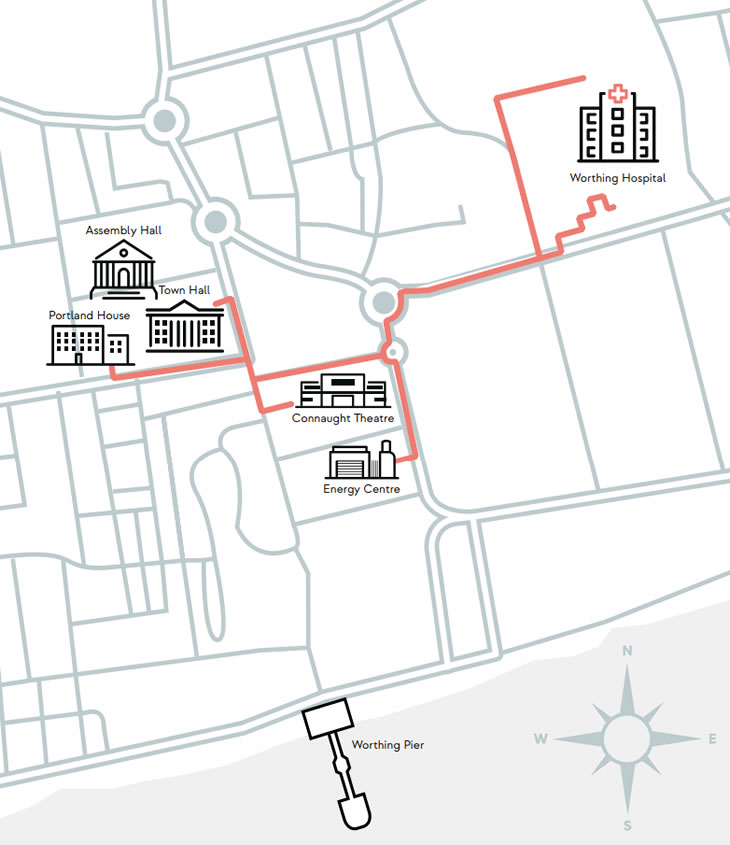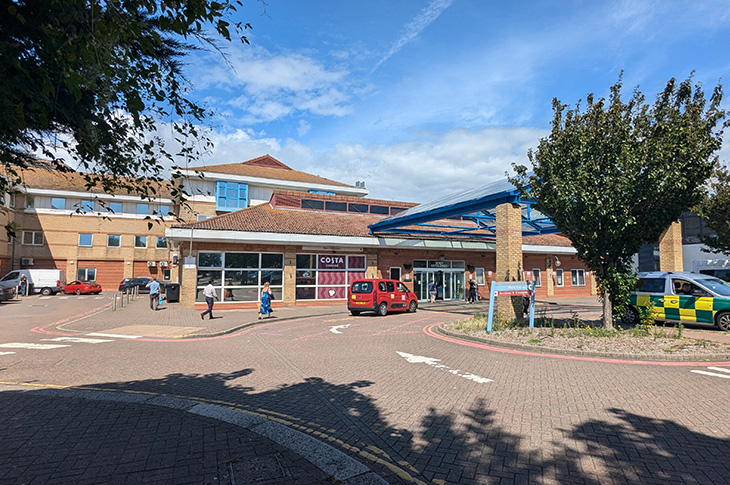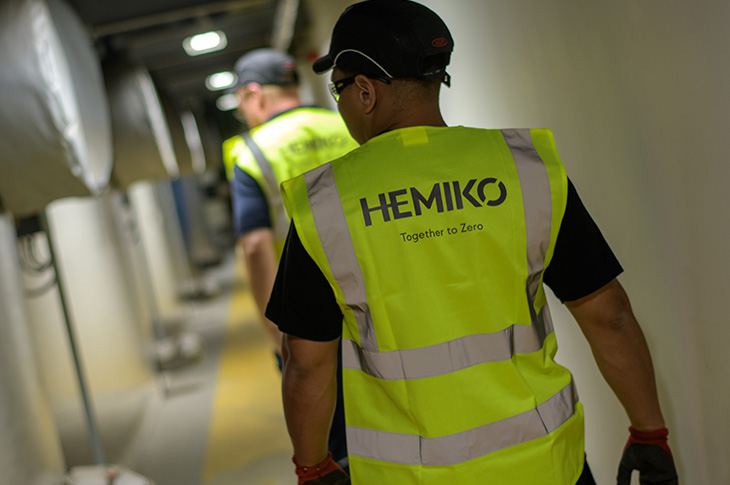Worthing Heat Network
About the heat network project
We are working in partnership with low-carbon energy company Hemiko to deliver the Worthing Heat Network - a pioneering scheme which will bring sustainable heating to buildings and homes across the borough.
Hemiko, formerly known as Pinnacle Power, will design, build and operate the heat network, which forms a key part of our commitment to become a carbon neutral council by 2030 and a net zero area by 2045.
Heat networks are an alternative to gas boilers and provide heating and hot water to homes and buildings through a network of insulated underground pipes.
Although heat networks are relatively new to the UK, they are common in Scandinavia and will become increasingly popular as more towns, cities and countries look to meet their carbon targets.
The first phase of the Worthing Heat Network, which is expected to be complete by 2026, is estimated to cut the town's carbon emissions by 3,000 tonnes a year - a figure estimated to be the equivalent of taking more than 2,000 cars off the road. Air quality will also be improved through its introduction.
Public buildings across Worthing's town centre will connect to the network first. As the project progresses, more buildings and homes will have the opportunity to join.
Hemiko, with the support of government grants, is investing £500m into the project, which is expected to drive economic growth and create dozens of jobs across the town, including opportunities for school leavers.
Video: the Worthing Heat Network
What is a heat network?
Heat networks operate by collecting local unused heat, turning it into hot water and distributing that hot water to local users through a network of underground pipes. They are a low carbon replacement for gas boilers, providing both heating and hot water.
Overall, in the right location, heat networks are 40% cheaper than using individual air source heat pumps for each building.
Why has the council decided to commission a heat network?
In 2019, we identified the Worthing Heat Network as the most economic and efficient way to decarbonise the town's civic quarter.
It will enable connected buildings to reduce their reliance on fossil fuels for heating and hot water, reducing their heating emissions by around 90%.
Map: Worthing Heat Network area - first phase (credit Hemiko)

How long will the Worthing Heat Network take to build?
Hemiko has said it will take about 15 months to construct the first phase of the heat network and connect the first buildings (listed below). Work began in summer 2024.
The low-carbon energy company has said it will offer a connection to every building in the town by 2050.
Which buildings will connect to the Worthing Heat Network first?
The first buildings to connect will be Worthing Town Hall, Worthing Hospital, Assembly Hall, Portland House, Worthing Museum & Art Gallery, and Connaught Theatre, with more to come over time. This first phase alone is expected to save 3,000 tonnes of carbon a year, the equivalent to taking 2,000 cars off the road.
Photo: Worthing Town Hall

How will the construction of the heat network affect Worthing?
To bring the Worthing Heat Network and its decarbonising benefits to life, a range of infrastructure, both underground and above, will need to be developed.
Hemiko will need to dig up roads and pavements across the town to install its network of underground pipes. The low-carbon energy company is working closely with West Sussex County Council's highways team to ensure that construction will cause as little disruption to road and pavement users as possible.
There will be various traffic management programmes in place, to protect both road users and Hemiko's working operatives. The works will result in a handful of lane closures, temporary traffic lights, one-way diversions and road closures, affecting Lyndhurst Road, Union Place, High Street, Chapel Road, Park Road and Richmond Road.
Hemiko says it will sequence the work to ensure that high season traffic can flow, and the town can thrive in its busy summer period. Some bus routes will be affected, but the low-carbon energy company aims to be as efficient as possible, working on weekends and extended days to minimise the impact.
Energy centres, which will house the heat pumps, thermal store and other equipment, will also need to be built across the borough - the first of which will be sited next to the High Street multi-storey car park. The other energy centres will be built further out of the town centre.
Image: Artist's impression of the energy centre in High Street, Worthing

How much is the Worthing Heat Network costing?
Following our application to the government's Public Sector Decarbonisation Scheme, we were awarded more than £7m of grant funding to contribute to the Worthing Heat Network. This unlocked £40m of investment from Hemiko, and they plan to invest in the region of £500m by 2050 as the network expands.
As part of our £7m award from the government, we are required to match fund the grant with a £3.2m investment that will go towards modernising our public buildings. This will see more energy efficient windows, doors, insulation and heating systems installed.
The NHS has also received approximately £19m in funding from the government to connect Worthing Hospital to the heat network.
Photo: Worthing Hospital

When can I connect to the heat network?
When you can connect to the heat network will depend on how far away you are from the network, and how many other buildings in your area also want to connect at a similar time. During the first few years the focus will be on connecting larger buildings, including new housing developments. Other residential properties nearer the town centre are expected to be offered a connection in the next five to ten years.
Will businesses and residents looking to connect to the heat network get a fair offer?
To ensure the heat network delivers a quality, valuable service for Worthing, we have established a Governance Agreement with Hemiko, which binds them to providing low carbon heat at a fair price and with excellent customer services.
From 2025, regulation will also apply in the heat networks market, giving customers added protection.
How many jobs will be created by the Worthing Heat Network?
The first phase of the Worthing Heat Network, which is expected to be complete by 2026, is expected to create around 40 local jobs. By 2050, Hemiko expects the network to have created up to 500 jobs.
Photo: Hemiko staff wearing hi-vis (copyright Hemiko)

Timeline for the project
Below is a diagrammatic map showing the construction timeline from Hemiko for the project, which will be updated over time:
Hemiko is engaging with local stakeholders to minimise disruption to traffic as a result of works on the highway. As with any roadworks, the final programme of work will be subject to approval by West Sussex County Council as the Highways Authority.
For more information see:

Need assistance with this service?
Get in touch:
Place & Economy Team
Page last updated: 07 January 2025



 01903 239999
01903 239999